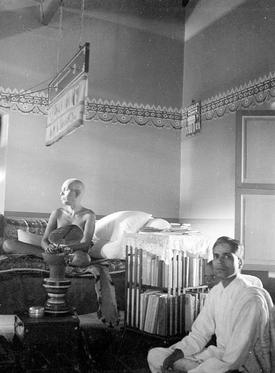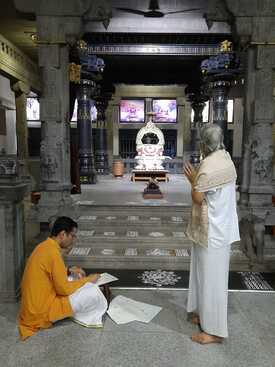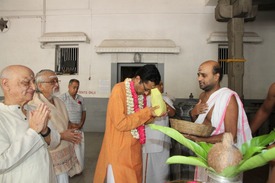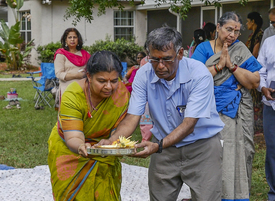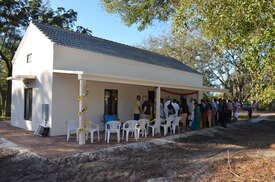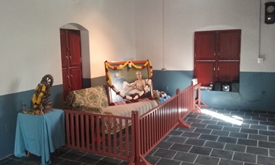“I Came, He Saw, He Conquered!”
From Skeptic to Devotee,
the Story of Sub-Registrar Narayana Iyer
Narayana Iyer, who came at first reluctantly to see Sri Bhagavan, was transformed by his presence into an ardent devotee. In the following recollection by Smt.T.R.Kanakammal, his devotion to Sri Bhagavan is highlighted along with his chosen sadhana of the repetition of Sri Bhagavan’s composition, ‘Ulladu Narpadu’ or ‘Forty Verses on Reality’. ‘Ulladu Narpadu’, the genesis of which was given in the last issue of 'The Maharshi', is a series of inspired verses which encapsulates the upadesa given by Sri Bhagavan.







Narayana Iyer was a devotee who came to scoff but who remained as a worshipper. He was an out-and-out skeptic with no religion in him. He considered sannyasins and sadhus to be impostors and parasites and no one, however great, had the right to accept the homage of others. But a chance meeting with Sri Bhagavan wrought a complete transformation in this doubting Thomas and turned him into a staunch devotee.
Dr. Ramakrishna Iyer, his philosopher and guide, who like Narayana Iyer was also working in Chetpet [1], was well acquainted with Sri Bhagavan, being the son of Lakshmi Ammal of Tiruchuzhi who had been one of Sri Bhagavan's childhood playmates. He invited Narayana Iyer to go with him to Tiruvannamalai during Deepam festival and his invitation was accepted although Narayana Iyer disliked crowds, and temple festivals had no attraction for him. He agreed on the condition that he would neither come inside the Asramam nor prostrate to the Swami if perchance he met him.
Circumstances forced him to accompany his friend into the Asramam. As they were coming inside a person clad only in a white loin cloth, a towel on his shoulder, a kamandalu in one hand and a walking stick in the other stopped in his walk in the opposite direction on seeing them. He spoke kindly to the doctor and inquired about his mother and brother. Though Iyer guessed that this must be the Maharshi, he did not look up, thinking that, after all, he was a complete stranger to him. On being introduced as the Sub-Registrar of Chetpet, out of courtesy he looked up. Let us hear him now in his own words:
“What a wonderful face and what a welcoming smile! Bewitching, fascinating and a powerful look too! In a moment I was at His feet on the gravel ground...He is not bogus...looks genuine...but has He solved the mystery of life, of the universe, that we see around us? If not, I withdraw my homage and go my way... I tried to find out if He had written any books. I got a copy of Ulladu Narpadu in Tamizh just published.” As he tried to read the first stanza he was confounded and filled with dismay at the repeated use of the word ‘ulladu’ (reality, being) which seemed too closely packed. The pure language embodying the essence of Absolute Reality would drive even pandits of Tamizh prosody to despair. Someone nearby said that the Maharshi Himself would explain to them the forty verses that night. In anxious and eager suspense Narayana Iyer waited for the night.
“A solemn stillness pervaded the air. There was absolute silence. The Maharshi read the first verse. The mere reading of it made the meaning as clear as clarity itself. Verse by verse, He read and explained in a voice so sweet and melodious that it seemed to come from a transcendent being. The climax came when explaining the verse. He said, ‘God cannot be seen with our eyes and known by our senses. This is what is meant by saying, Seeing God is to be God.’ “Suddenly the stentorian voice of Dandapani Swami boomed out from among the listeners. ‘Is Sri Bhagavan saying this out of personal experience – swanubhava?’
“The question asked with such a naivete was answered with equal candor, ‘Else would I dare to say so?’”
It flashed upon Narayana Iyer instantly that if he whom all religions acclaim as god were to appear before him in flesh and blood, here he is. Successive waves of bliss flooding from within shook his frame. He went outside to compose himself. Narayana Iyer later wrote, “I came, He saw, He conquered.” The spell was thus cast. To him, henceforth, Sri Bhagavan was his God. Sri Bhagavan was the way and the support on the way as well.
To Narayana Iyer, the content of Ulladu Narpadu became Vedic verity and its verses veritable mantras, and he took to chanting them as japa. From then on nothing could stop him from frequenting the Asramam.
His job entailed frequent transfers; however, there was no letup in his regular visits. Never a Sunday passed without Narayana Iyer arriving at the Asramam and he always had some delectable snacks with him which had been prepared by his wife Lalita Iyer who believed that she was cooking delicacies for God. These were savored by everyone as Sri Bhagavan would never accept anything unless there was enough for all. Once when Shantammal inquired of Sri Bhagavan whether she could prepare some snacks in the Asramam, Sri Bhagavan replied: “Tomorrow is Sunday. Narayana Iyer will be arriving and will surely be bringing something to eat."
In the afternoon, devotees bringing snacks would offer the entire lot, in their containers, to Sri Bhagavan. After a quick look around the Hall, Sri Bhagavan would pick up a little and hand over the rest to the attendant nearby to be distributed in equal measure among those present. Muruganar, a keen observer of Sri Bhagavan's ways, used to recall with wonder, that if the attendant gave each one present exactly the same amount that Sri Bhagavan had taken, it would just suffice for all, whether the number present was great or small. This was found to be unfailingly true; whatever the quantity Sri Bhagavan allotted for himself was found to be the right quantity for distribution to all that day.
In those days (the early thirties), the area surrounding the Asramam was very bare. Mother's shrine was yet to be constructed. Anyone approaching the precincts of the Asramam could be easily seen from the Old Hall. Once, between two successive weekend visits by Narayana Iyer, the Asramam administration, feeling that Sri Bhagavan needed some rest in the afternoon after lunch, had imposed a restriction that no one should be allowed to enter the Old Hall between twelve noon and 2 p.m.
Neither Sri Bhagavan nor Narayana Iyer was aware of this new decree. The following Sunday afternoon, as usual, Iyer arrived with omappodi (a snack made of gram flour and spices) in hand. As he approached the Hall those strategically positioned to deflect the wouldbe visitors until 2 p.m., the new receiving hour, apprised him of the rule. Iyer, though still at a great distance from Sri Bhagavan, made his customary prostration from where he was, retraced his steps and waited until the appointed hour.
At 2 p.m. he came before Sri Bhagavan. Sri Bhagavan had spied him on his arrival and disappearance. As soon as he entered the Hall, Sri Bhagavan asked him: “Didn't you come at one o' clock? I saw you through the window and was expecting you to come to the Hall at any moment. But you didn't come. Did you have to go elsewhere?” Narayana Iyer, who had no idea that Sri Bhagavan was not supposed to know of the new arrangement, replied in all innocence, “My train arrived late and I could come only at one o' clock but was informed that Sri Bhagavan nowadays rests in the afternoons and is not to be disturbed until 2 p.m. Hence I have come only now.”
Sri Bhagavan listened without any comment other than his customary, “Oh, is that so?”
The next day after lunch, instead of going into the Hall, Sri Bhagavan sat outside the Hall. The attendant very hesitantly suggested that he go inside as it was becoming very hot.
Sri Bhagavan said, “Nobody is allowed to enter the Hall until 2 p.m. Is there also a rule that I should not come out until two?”
Then Sri Bhagavan, the very embodiment of compassion, added, “People come from far away places by various means, suffering innumerable hardships in order to get here. How can they be sure of the exact time of their arrival? When they come after all that, how fair is it to deny them ready access?”
Hearing this, the management immediately revoked the new rule.
Owing to the profound grace of Sri Bhagavan, in due course Narayana Iyer was posted to Tiruvannamalai itself. He was the first in the long line of devotees to have had the rare privilege of establishing a residence near the Asramam in order to be in the holy presence of Sri Bhagavan on a regular basis. His entire sadhana comprised of simply remaining with Sri Bhagavan whenever possible, in the Hall or in the kitchen, cutting vegetables, grinding chutney and preparing breakfast in the wee hours of the morning. Prior to constructing his house, Iyer took the plans to Sri Bhagavan to have them blessed. After careful perusal Sri Bhagavan observed, “The plan is alright. But where is the well?”
Though Iyer had a location in mind, it was not marked on the blueprint. This turned out to be a benediction, as Sri Bhagavan selected the site and marked the exact location. Later on, one could see what a blessing it was. Not only was the water as sweet as tender coconut water, but the well never ran dry and was thus a source of succor for the entire neighborhood in times of severe drought.
His wife Lalita was a truly sattvic woman, given to dharmic ways and scrupulously adhering to the sastraic injunctions pertaining to a Brahmin housewife. Simple, carefree and unattached, she ran the household with a contented mind and to the satisfaction of the entire family, making optimum use of the resources available to her.
Sub-Registrar Narayana Iyer derived inordinate pleasure in serving his cow. Tending his garden was also dear to him. The occasions when his cow was about to give birth were significant enough to merit a day's leave from his work. This exclusive privilege, Mrs. Iyer humorously used to remark, was the cow's alone, and not extended to his wife for her deliveries.
Iyer's one passion was to chant Ulladu Narpadu unceasingly. Neither conventional Vedic duties nor extravagant ritualistic observances had any attraction for him. The constant chanting of Ulladu Narpadu was all the religious observance known to him. It would start right from the morning.
Dyed in South Indian Brahminical custom, Narayana Iyer looked forward to his invigorating cup of morning coffee. The person who milked the cow used to turn up at 5.00 a.m. announcing his arrival by ringing his bicycle bell. Iyer, who would invariably be chanting Ulladu Narpadu loudly, would open the gate for him. The day would, therefore, begin with Ulladu Narpadu, a routine so predictable and punctual that the neighbor opposite him, an Andhra lady, remarked that she could safely set her clock by his recitation in the morning. His chanting continued throughout the day while he watered the plants or gave the cow a bath.
If ever he were to hear a voice raised in argument among children, he would simply raise his voice and chant louder. It was a wonder to see the children immediately quietened as if the mesmerizing spell of this powerful mantra made them aware of Sri Bhagavan's very presence.
Iyer had unshakable conviction that Ulladu Narpadu was verily Upanishadic truth. The Taittiriya Upanishad of the Asramam's Vedic parayana extols the greatness of OM. As per the Vedic tradition, the sacrificial fire during havan is ignited with this single syllable. Permission to offer the oblation is sought with this OM and granted with OM. Ulladu Narpadu, for Iyer, enjoyed a similar exalted status.
I [Kanakammal] stayed in Iyer's compound occupying a small cottage for ten years. He looked upon me as his own daughter. He always made himself aware of my requirements when he procured groceries for his own household and would always meet my needs.
Nights were an ideal time to be with Sri Bhagavan though the ladies were not allowed this privilege. In the sweet and silent hours of the early night, permeated by the powerful presence of Sri Bhagavan those around him never knew the passage of time. That was when Sri Bhagavan regaled devotees with the most interesting stories and soul-stirring incidents immersing them all in waves of bliss. And what bliss it was to be alive then! To be in the Presence was heaven indeed. These few devotees had Sri Bhagavan exclusively to themselves, for even the attendants would quietly depart, leaving them alone with Sri Bhagavan.
As Bhagavan's Mahanirvana approached, Narayana Iyer was never far from Sri Bhagavan. At that time, Sri Bhagavan's water pot and walking stick were in his room as he could not use them anymore. Iyer sensed that several people had secret designs on them wanting to take them away and preserve them as private, sacred relics. After the Mahasamadhi, abhishekam and aarti were performed and the holy body was taken in procession in a small ratha (a hand-drawn cart) around the Mother's shrine. Iyer took this opportune moment and picked up the walking stick and kamandalu and slowly walked ahead of the ratha up to the Samadhi chamber where the body would be enshrined. He descended into the chamber where the body was placed and laid Sri Bhagavan's walking stick and kamandalu on either side of the body. The Samadhi pit was then slowly filled in.
In the aftermath of Sri Bhagavan's Mahanirvana, Iyer did not give up his earlier routine of having Sri Bhagavan's darshan daily. He had darshan of Sri Bhagavan at the Samadhi Shrine and continued to visit the Old Hall. The Iyers stayed on in Tiruvannamalai as did Chadwick who, for a time, took up residence in the Iyer compound in a small thatched-roof cottage until he was invited by the Asramam management to move back there again. Later in life, the Iyers moved to Madras where their children took care of them in their old age.
Narayana Iyer and his wife were in the grihastha (householder) asramam and followed dharma meticulously. Yet mentally both had donned the ochre robe and the way they lived was a penance (tapas) that required no other spiritual practice. Wherever Iyer went his continued recitation of Ulladu Narpadu made the air around him vibrant with the holy presence of Sri Bhagavan, compelling an inner response from all.
Dr. Venkat S. Ramanan Inaugurated
as New President of Sri Ramanasramam
Dr. Venkat S. Ramanan, son of Sri V.S. Ramanan, has been inaugurated as the fourth President of Sri Ramanasramam. We shall forever be grateful to Sri V.S. Ramanan, known among devotees simply as Sundaram, for his enduring legacy in bringing the teachings of Sri Bhagavan to an everexpanding family of devotees and for his exemplary lifelong one pointed devotion to our guru and refuge Sri Ramana.
President Sri V.S. Ramanan succeeded his father T.N. Venkataraman as the President of Sri Ramanasramam in 1994. During his 26 years as President, the teachings of Sri Ramana Maharshi were made accessible to an everincreasing number of devotees worldwide. This is due in part to Sri V.S. Ramanan's strong support of the translation and publication of Sri Bhagavan's works in numerous languages, as well as the restoration, preservation and sharing of Sri Bhagavan's photographs. Bringing the Ashram into the digital age allowed devotees who were not physically present at Sri Ramanasramam to bask in the presence of Sri Bhagavan by viewing Ashram events such as Jayanti, Mahapuja, Aradhana and Kartigai Deepam via live webcasting.
While the natural process of ageing and accompanying medical conditions took a toll on his physical health, Sri V.S. Ramanan’s enthusiastic devotion was not affected in the least. However, he realized that the time had come to hand over responsibility for the Ashram to his son, Dr. Venkat S. Ramanan (Anand). In 2018, with the blessings of Sri V. Ganesan and Sri V. S. Mani, Dr. Venkat S. Ramanan was nominated to become the next President of the Ashram.
Recently, when Sri V.S. Ramanan's health suffered a setback, Dr. Ramanan returned from the USA to India, abiding by all pandemic-related public health requirements, in order to be with his father and mother, Smt. Susila Ramanan.
The legal documents required to assume responsibility as the fourth President of the Ashram were completed and signed in front of Sri Bhagavan's shrine on the morning of June 17th, 2020 and a homa to commemorate the event was performed on June 18th in the New Hall.
We wish to offer our sincere thanks to Sri V.S. Ramanan for his guidance and friendship to Arunachala Ashrama over these many years, and we welcome Dr. Venkat S. Ramanan as the incoming President of Sri Ramanasramam. May Sri Bhagavan shower his blessings on our new President, on Sri Ramanasramam, and on his devotees the world over!
The past and future depend for their existence upon the present which is experienced daily. Whilst they are occurring, these too are the present. The present alone exists. To attempt to understand the past and future without having ascertained the truth of the now is like trying to count without the number one.
Without us there is neither time nor space. If we are only bodies, we are caught up in time and space. But are we bodies? Now, then and always, – here, now and everywhere – we are the same. We exist, timeless and beyond space.
The Story of the new 'Old Hall' of Tampa, Florida
It is our privilege to share here a story that began in the 'Old Hall' of Sri Ramanasramam in Tiruvannamalai, South India with an overwhelming experience of grace and peace, an experience that kindled an ardent desire in the pure heart of a noble devotee.
It was during a visit to India in 1999 that Mathy Rathinasamy entered the 'Old Hall' and was blessed with the unmistakable experience of coming home to a place of ineffable peace within herself, to her spiritual home – a place of limitless love, protection, beatitude and the satisfaction of one’s heart’s deepest yearnings. In reality, this experience was not unique to her; rather, it has been the experience of untold numbers of devotees the world over who, on stepping into the intimate space where Bhagavan Sri Ramana spent so many years, have also felt themselves in the embrace of their loving father’s care, in his home.
When a persistent notion or yearning arises in the pure heart and undivided mind of a loving devotee, the Lord is powerless and must bring such desire to fruition!
Dr. Rathinasamy together with his devoted wife, Mathy, moved to the Tampa area in Florida in 1985. It was there that he set up his medical practice and they raised their family. As the Rathinasamys approached their retirement years, it was Mathy’s hope to return to Tiruvannamalai, to the place where she had first been blessed with the knowledge of her spiritual teacher and spiritual home. Yet, her family had put down roots in the community of Tampa in Florida. Mathy asked Dr. Rathinasamy if they might build a meditation hall in which to serve and remember God. On first mention, Dr. Rathinasamy assumed it would be a conventional meditation hall. But Sri Bhagavan himself had put into Mathy’s heart the desire to recreate the space in which she had first felt herself in the presence of the Master. Dr. Rathinasamy rejoined that Sri Bhagavan’s main teaching was mounam or silence, and the place in which one meditated need not be the most important consideration. To this Mathy responded, “I am not in the mouna state yet! I would like to feel that I am THERE with HIM in HIS Hall!” As an ideal couple, living and learning from one another and supporting one another, Dr. Rathinasamy, agreed to support his wife’s wish and to learn from her wisdom. A property was purchased within easy walking distance from the Hindu Temple of Florida in Tampa where the Rathinasamys have been supporting members for years.
It was December of 2015. Mathy was sitting at the chosen building site in silent communion with her master Sri Ramana. Up until then her heart’s pleas had been urgent: “Will you come? When will you come?” To her astonishment, Mathy suddenly heard the Master’s voice. Sri Bhagavan’s words: “You wanted me to come! I am here! Now what?”
It was here that, during the Jayanti Retreat of 2015, Dennis Hartel of Arunachala Ashrama of New York City and Nova Scotia, Canada, learned of Mathy’s noble aspiration. From this moment on divine grace took up the cause! All information with respect to precise dimensions and building materials used in the original 'Old Hall' was received from Sri Ramanasramam. Dennis’s brother, James Hartel, lovingly oversaw the woodworking with the help of Timothy Mulroy and Bill Miller of Windhill Woodworks, Inc., Franklin NY, and Jim personally travelled all the way from New York to South Florida to assure the precision and quality of the work.
On one occasion, when a beam was a fraction of an inch off in length, it was re-done. On another, the rafters were set to be installed 9 inches lower than those of the original 'Old Hall' and they were raised to the correct height under Jim Hartel’s careful eye. Mathy obtained the authentic hardware for the shutters and doors from India. The replica was to be precise! Artist devotee Janet Rubinson, with the support of her husband, Dave, painted the new 'Old Hall’s beautiful border design in the most intense heat! Sri Bhagavan was accepting the work from his votaries who were blessed in return!
The many devotees who arrived for Jayanti Retreat the following year were able to walk into the new 'Old Hall' and to experience the Master’s living presence. A joyous dedication took place on December 29th of 2016 during the same retreat. Following the inauguration, Mathy once again found herself looking into the eyes of Bhagavan enveloped in gratitude and grace. It was at this time that Mathy came to understand that the 'Old Hall' replica that she and Dr. Rathinasamy had been instrumental in creating was not to be for herself alone but would serve as a place of peace, solace and inspiration to the Master’s many children.
Veda Parayana from the new 'Old Hall'
It is an age-old adage universally understood that from hardship proceed blessings. Since the beginning of the year, with the spread of the global pandemic and the resulting uncertainty experienced by many, devotees of Sri RamanaArunachala across the globe have risen to the occasion, seeking to share the blessings of the peace of Sri RamanaArunachala through digital means, organizing satsangs now unlimited by geographical boundaries.
During Sri Bhagavan's lifetime, the chanting of the Vedas occurred twice daily, lasting approximately 40 minutes during the morning and evening. This is a practice that is followed even to this day at Sri Ramanasramam.
From the beginning of May, Evening Vedaparayana has been broadcast from the new 'Old Hall'. This is the inspired offering of Mathy Rathinasamy surrounded and supported by her community of Ramana devotees of South Florida. Evening Veda Parayana from the Tampa new 'Old Hall' begins at 5:30 p.m. Monday through Friday, and at 5 p.m. on Saturday and Sunday. The Vedas are followed by 15 minutes of silent meditation. Friday evenings beginning at 5:30 are dedicated to Sri Lalitha Sahasranam. Devotees may listen or chant along. All are invited to join the Tampa Veda Parayana.
(Please sign on five minutes early so as to allow for time to be admitted.)
The story of the new 'Old Hall' in Tampa continues to be told – a story to be written in the hearts of the Master’s devotees. It is the Rathinasamys' wish that the Hall may serve as a place radiant with Sri Bhagavan’s divine teaching of Self-knowledge and self surrender imparted in the silence that he himself described as “unceasing eloquence”.
You Must Cling Too
In India we compare the aspirant who strives to the child of the monkey that clings to its mother as she jumps from tree to tree and the devotee who relies completely on the grace of the Guru to that of the cat that is quite helpless and is therefore picked up by its mother and carried in her mouth. Alluding to this, I said once that I was like the kitten and had cast the whole responsibility on Bhagavan. He laughed but would not agree. He said “Both are necessary; I will hold you but you must cling too.”
Updates
Due to continuing health restrictions, Arunachala Ashrama, New York remains closed to visitors until further notice. Please visit our web page for the latest information. The Ashrama has been having regular satsangs online which can be found on our virtual events page. Devotees’ digital offerings are shared on the Ashrama’s peace portal.
The Nova Scotia Arunachala Ashrama will remain open to daytime visitors but will not have any overnight guests for the remainder of the year. We all wish to help keep everyone safe in this time of COVID.
For a listing of other centers that are offering virtual satsangs at this time, please see our online satsangs.
[1]



